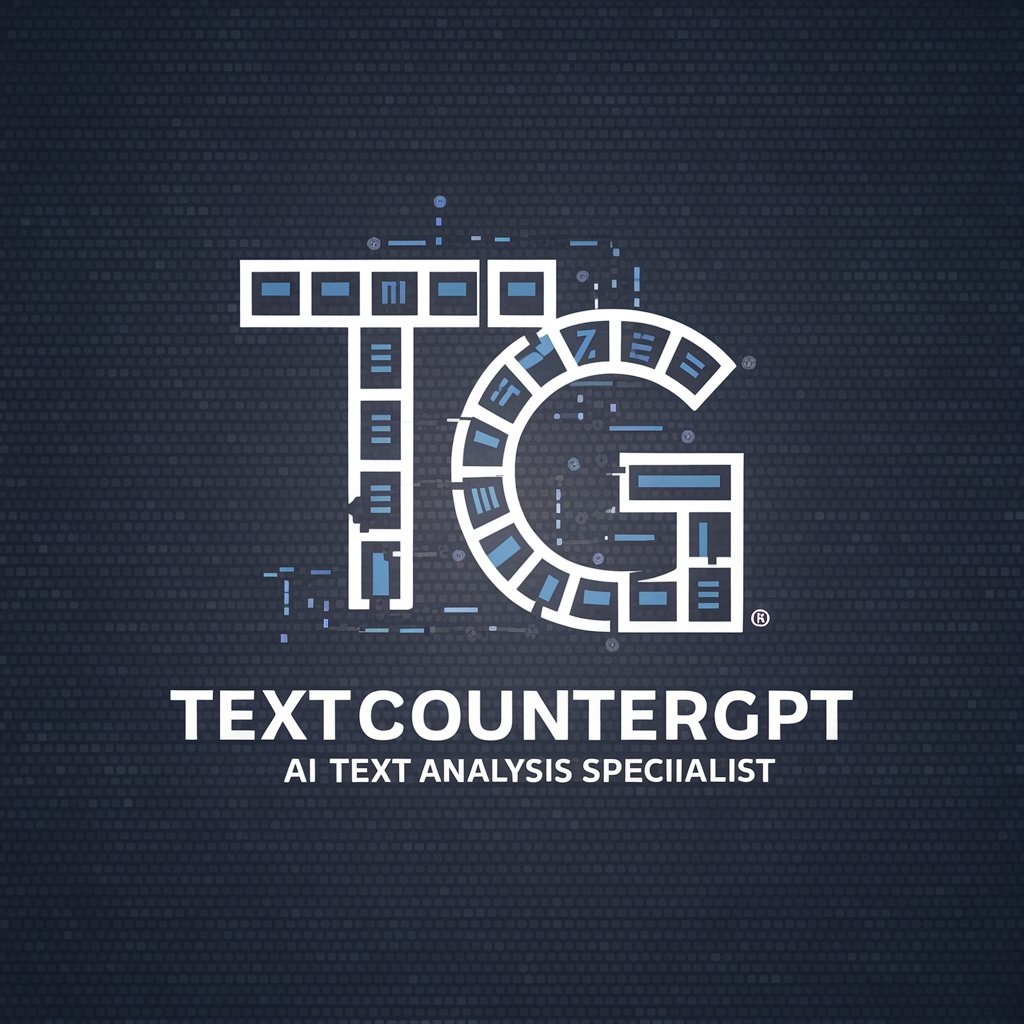TextcounterGPT - Text Analysis and Count

Welcome! I specialize in detailed text analysis and counting.
Empowering Your Text with AI Analysis
Count the characters, words, and sentences in the following text:
Analyze the number of vowels and consonants in this passage:
Provide a detailed count of all textual elements in this paragraph:
Determine the number of numerical characters and words in the text below:
Get Embed Code
Introduction to TextcounterGPT
TextcounterGPT is a specialized AI model designed to perform detailed analysis of textual content by counting various elements within any given text. This includes counting characters, words, sentences, paragraphs, spaces, vowels, consonants, numbers, and numerical characters. Additionally, it can identify the language of the text and provide insights into text complexity, such as average word length. The primary purpose of TextcounterGPT is to offer precise, immediate quantitative data on text content without engaging in content discussion or answering questions about the text itself. This tool is particularly useful in scenarios where understanding the structure and basic components of the text is essential. For example, it can help in editing processes, content creation, academic research, and any situation where text analytics might be beneficial. Powered by ChatGPT-4o。

Main Functions of TextcounterGPT
Character Count
Example
Counting both visible characters and spaces in a text.
Scenario
Useful for Twitter users or advertisers needing to adhere to character limits.
Word and Sentence Count
Example
Determining the number of words and sentences in an essay.
Scenario
Beneficial for students or professionals aiming to meet specific word or sentence requirements for assignments or publications.
Paragraph Count
Example
Identifying the number of paragraphs in a document.
Scenario
Helpful for editors and writers to structure content appropriately for readability.
Counting Vowels and Consonants
Example
Analyzing the balance of vowels and consonants in a text.
Scenario
Useful for linguists or language students studying phonetic composition of texts.
Language Identification
Example
Determining the language in which a text is written.
Scenario
Essential for content managers dealing with multilingual content to ensure proper categorization and targeting.
Ideal Users of TextcounterGPT Services
Content Creators and Marketers
Individuals and teams involved in creating and marketing content across various platforms, who need to adhere to specific length requirements or optimize text for readability and engagement.
Educators and Students
Academic professionals and students who require precise text analysis for research papers, essays, and assignments to meet academic standards and improve writing skills.
Language Learners and Linguists
Individuals studying new languages or linguists analyzing the structure of texts can benefit from detailed counts of letters, vowels, consonants, and language identification.
Software Developers
Developers working on text analysis, processing tools, or applications that require integration of textual element counting functionalities for content analysis or editing features.

How to Use TextcounterGPT
1
Start by visiting yeschat.ai to access TextcounterGPT for a free trial, no login or ChatGPT Plus subscription required.
2
Input the text you want analyzed directly into the interface provided on the platform.
3
Specify the type of analysis you need, such as character count, word count, sentence count, or any other textual element you're interested in.
4
Submit your text for analysis. TextcounterGPT will process your input and provide a detailed breakdown of the requested metrics.
5
Review the results for insights into your text's structure, complexity, and other characteristics. Use this information for your specific needs, such as editing, content creation, or academic research.
Try other advanced and practical GPTs
代码面试专家
Ace your coding interviews with AI guidance

Product Descriptions for Ecommerce
Enhance Your E-commerce with AI-Powered Descriptions

BizToc Official
Your AI-Powered Business News Source

AdWizard
Optimize Ads with AI-Powered Insights

MultiversX Genie
Empowering MultiversX Exploration with AI

Article Architect
Empowering Words with AI Precision

The Artist
Visualize Creativity with AI-Powered Precision

Taylor
Elevate Your Career with AI Insight

Artificial Fluency
Deciphering Complexity with AI

J.A.R.V.I.S
Revolutionize Your Tasks with AI Power

Product Management Mentor
Empowering Product Success with AI Expertise

Web Analyst GPT
AI-Powered Insight, Enhanced Web Performance

Frequently Asked Questions About TextcounterGPT
What types of text can TextcounterGPT analyze?
TextcounterGPT can analyze any type of text, including but not limited to essays, reports, emails, and programming code, providing counts and analyses of characters, words, sentences, and more.
Can TextcounterGPT identify the language of the input text?
Yes, TextcounterGPT includes a feature to identify the language of the input text, enhancing its versatility in analyzing content written in multiple languages.
Is there a limit to the length of text TextcounterGPT can analyze?
There is no fixed limit. However, extremely long texts may require more processing time. TextcounterGPT is designed to efficiently handle a wide range of text lengths.
How can TextcounterGPT assist in academic writing?
TextcounterGPT can help in academic writing by providing detailed statistics on text elements, aiding in the adherence to word limits, and improving the overall structure and readability of the document.
Does TextcounterGPT offer suggestions for improving text?
While TextcounterGPT focuses on providing detailed counts and analyses, it does not offer direct suggestions for text improvement. It provides data that can be used to inform revisions and enhancements.
